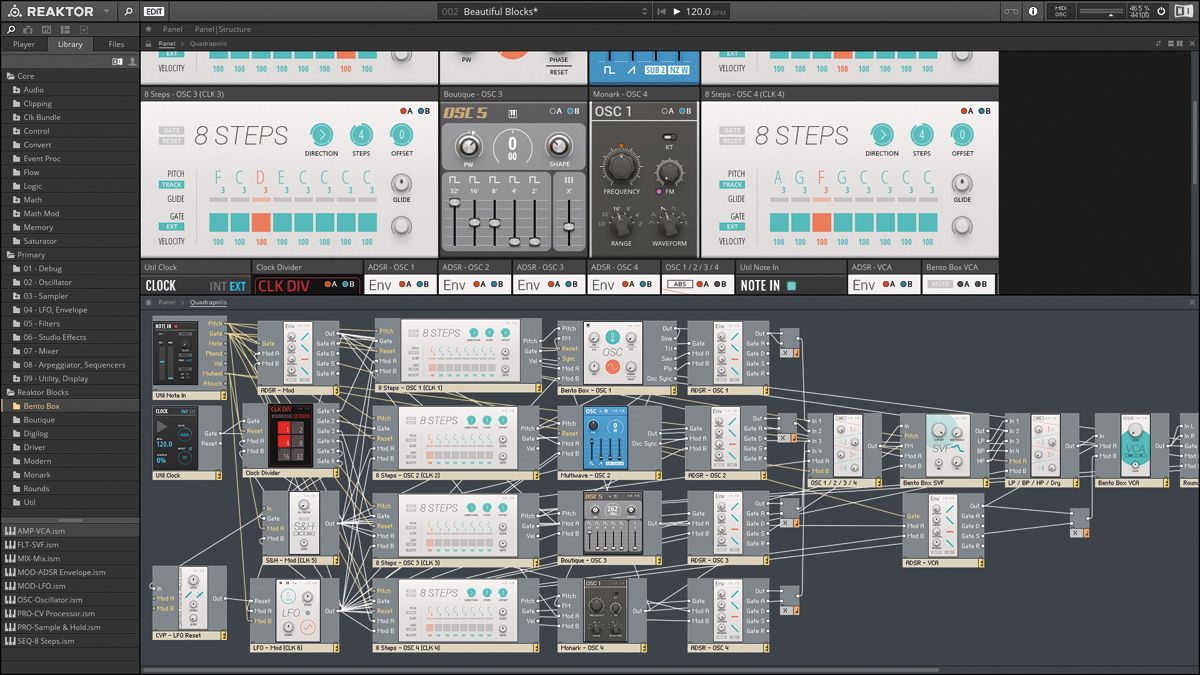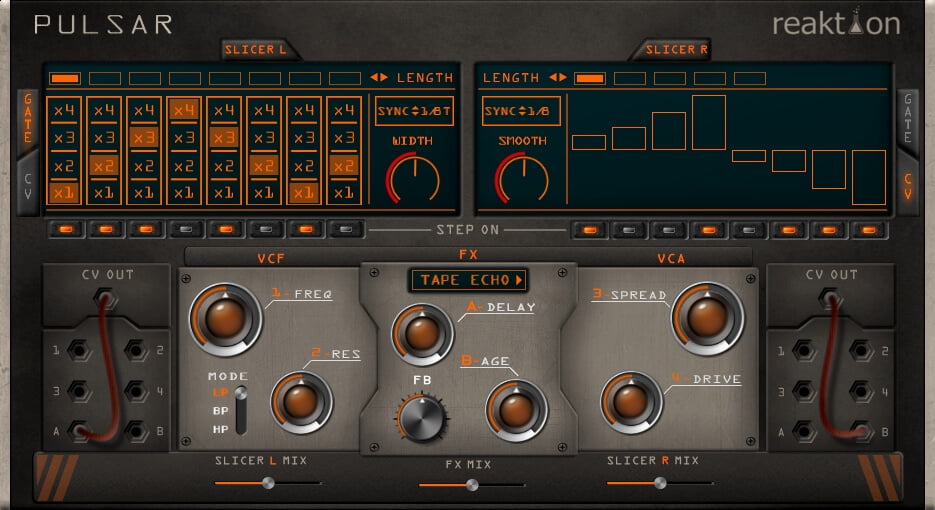| Developer(s) | Native Instruments |
|---|---|
| Stable release | |
| Written in | C++[1] |
| Operating system | macOS, Microsoft Windows |
| Type | Modular software music studio |
| License | Proprietary |
| Website | Reaktor 6 homepage |
Reaktor 6 is a phenomenal update that improves on NI's already amazing softwarein practically every area, from the Table Framework-enhanced fundamentals to the re-organised library, smart visuals, and, of course, the incredibly exciting Blocks.
Creating a unique and responsive custom GUI in Reaktor is an important part of making an immediate impression on your users. In this series, I’ll go over a variety of ways we can improve upon Reaktor’s default knobs, in order to create a better user experience. REAKTOR 6 Demo Tracks Introducing REAKTOR 6 TRUE SONIC PLAYGROUND REAKTOR 6 is the ultimate creative toolkit for deep sound exploration, featuring cutting-edge DSP and high-fidelity sound. FOR SOUND MAKERS Looking to take full control of your sounds, or create something never heard before? REAKTOR is the beating heart that gives life to synths.
Reaktor is a graphical modular software music studio developed by Native Instruments (NI). It allows musicians and sound specialists design and build their own instruments, samplers, effects and sound design tools. It is supplied with many ready-to-use instruments and effects, from emulations of classic synthesizers to futuristic sound design tools. In addition, more than 3000 free instruments can be downloaded from the growing User Library. One of Reaktor's unique selling points is that all of its instruments can be freely examined, customized or taken apart; Reaktor is a tool that effectively encourages reverse engineering. Reaktor Player is a free limited version of the software that allows musicians to play NI-released Reaktor instruments, but not edit or reverse-engineer them.


Development History[edit]
Early development[edit]
In 1996, Native Instruments released Generator version 0.96 - a modular synthesizer for PC, requiring a proprietary audio card for low-latency operation. By 1998, Native Instruments redesigned the program to include new hierarchy, and integrated third-party drivers for use with any standard Windows sound card. By 1999, Reaktor 2.0 (a.k.a. Generator/Transformator) was released for Windows and Macintosh. Integrated real-time display of filters and envelopes and granular synthesis are among most notable features. Plug-in support for VST, VSTi, DirectConnect, MOTU, and DirectX formats is integrated by 2000 (software version 2.3).

With version 3.0 (released in 2001), Native Instruments introduced a redesigned audio engine and new graphic design. Further expansion of synthesis and sampling modules, addition of new control-based modules (XY control) and data management (event tables) greatly expands the abilities of the program. The earliest version to really resemble the modern incarnation of the software is version 3.5, which improved greatly in VST performance and sample handling. Reaktor 3.5 is the first release that features full cross-platform compatibility.[2]
Reaktor 4 was a major enhancement in terms of stability, instrument library, GUI, and VSTi ease-of-use in external sequencers. It shipped almost six months behind schedule.[citation needed]
Version 5[edit]
In 2003 Native Instruments hired Vadim Zavalishin, developer of the Sync Modular software package. Zavalishin ceased the development of his software,[3] yet integrated a deeper DSP-level operation within Reaktor, known as Reaktor Core Technology.[4] His contributions, along with those of Reaktor Core developer Martijn Zwartjes, were released within Reaktor 5 in April 2005. Core Technology initially confused a lot of instrument designers because of its complexity, but is now steadily making its way into new instruments and ensembles.[citation needed]
Reaktor 5.1, released on 22 December 2005, and presented as a Christmas present, features new Core Cell modules, and a new series of FX and ensembles. Also a number of bug fixes were implemented.
The release of Reaktor 5.5 was announced for 1 September 2010. It features a revised interface as well as other changes.
Version 6[edit]
Reaktor 6.0 was released on September 9, 2015. It features many new improvements for advanced programmers. A new 'Blocks' feature allowed for the development of rackmount style modular 'patches' for creating synthesizers and effects.[5]
Functionality[edit]
From the end-user standpoint, Reaktor is a sound creation/manipulation tool with a modular interface.[6] Its patches consist of modules, connected by lines to provide a visual interpretation of signal flow. The building blocks used give Reaktor users freedom of choice to help shape their sound design. The modules are categorized into particular hierarchy to aid clarity in patching.
The patcher window allows one to navigate the inner structure of user's models. Many factory-shipped objects within Reaktor can be accessed and edited, and new objects can be generated on the fly. Each of the Reaktor modules is defined by its inner workings, and expansion thereof to the users' specification comes with relative ease.[7]
The objects that are available within Reaktor range from simple math operators to large sound modules. Kabbalah numerology reading. Implementation of Core Technology with version 5 enables user to view and edit the structure of any 'Core Module' building block. Although such editing can be an exceptionally powerful tool,[8] successful manipulation of Core Cells with predictable results requires in-depth knowledge of algorithmic implementation of signal generation and processing. Native Instruments promote this functionality with online side-by-side comparison of Core implementation of simple DSP algorithm against C++pseudocode.[9][10]
Reaktor enables a user to implement variables (static or dynamic) which are used as defining properties of the patch. Users have an ability to generate a GUI of their own to provide dynamic control to their systems. Starting with version 4, Reaktor supports user-generated graphical content, enabling many users to generate original look and feel of their instruments.
A finished Reaktor ensemble may be loaded into a host sequencer (such as SteinbergCubase or Ableton Live), and used as a stand-alone software plug-in for audio generation or processing (a multi-format proprietary loader is included with the software). Each panel control in the ensemble is capable of MIDI automation in the host sequencer.
Reaktor Ensembles[edit]
The Reaktor Library is one of the prominent features of the software, featuring a large variety of sound generators and effects that can be used as stand-alone instruments, or as an educational resource for reverse engineering. Reaktor 4 featured a library of 31 Reaktor ensembles. The fifth generation of software came with 32 new modules (though some were upgrades of Reaktor 4 Library tools). The libraries provide a mixture of conventional implementation of software synthesizers, samplers, and effects, along with a few ensembles of experimental nature, with emphasis on parametric algorithmic composition and extensive sound processing. Due to complete backwards-compatibility between later versions of the software, Reaktor 5 users have access to all 63 proprietary ensembles in Reaktor Library.
Furthermore, home-brew Reaktor ensembles can be shared by its users. Such exchange is encouraged by Native Instruments, characterized by the company's dedication for providing web-based tools and webspace for individual and third-party Reaktor extensions (this includes user Ensembles and presets for Reaktor Instruments and Effects).

Reaktor 6 Crack
See also[edit]
References[edit]
Reaktor 6 Crack
- ^'10 Years Of Native Instruments'. www.soundonsound.com.
- ^'REAKTOR TIPS'. SoundOnSound. May 2002. Retrieved 7 March 2007.Cite journal requires
|journal=(help)CS1 maint: discouraged parameter (link) - ^'SynC Modular Discontinued'. The Sonic Spot. 29 November 2000. Retrieved 8 March 2007.CS1 maint: discouraged parameter (link)
- ^'NI Reaktor 5'. Sound On Sound. 1 September 2005. Retrieved 8 March 2007.CS1 maint: discouraged parameter (link)
- ^https://www.native-instruments.com/en/products/komplete/synths/reaktor-6/
- ^'Native Instruments' Reaktor 5 Review'. FutureMusic. 8 May 2006. Retrieved 9 March 2007.Cite journal requires
|journal=(help)CS1 maint: discouraged parameter (link) - ^'NI Reaktor 5 Review'. Sound On Sound. 1 September 2005. Retrieved 9 March 2007.Cite journal requires
|journal=(help)CS1 maint: discouraged parameter (link) - ^'Reaktor 5: Core Technology'. Native Instruments. 2005. Archived from the original on 25 November 2006. Retrieved 9 March 2007.CS1 maint: discouraged parameter (link)
- ^http://co.native-instruments.com/index.php?id=r5core1
- ^http://co.native-instruments.com/index.php?id=r5core2
Reaktor 6 Mac
External links[edit]
| Wikibooks has more on the topic of: Reaktor |
Reaktor 6 Dll
